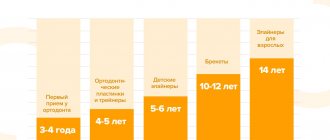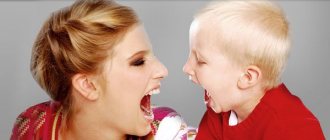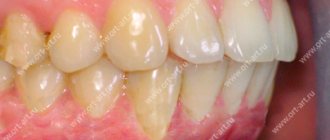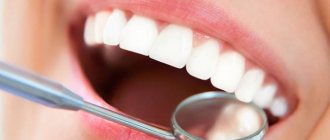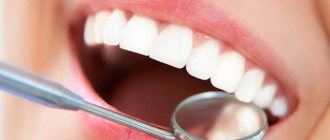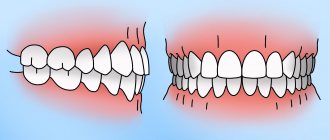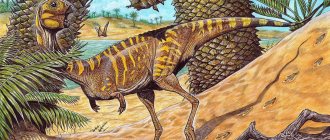Full health of a dog means the good condition of all its organs and systems, including teeth. Unfortunately, these friendly animals, which have served man faithfully for a long time, have not been spared many “human” diseases. One of them is an incorrect bite in a dog.
For breeding puppies or service breed dogs, this disease becomes a death sentence, excluding the right to serve or breed. In addition, this deficiency greatly affects the dog’s overall health.
Consequences of malocclusion for a dog's health
The chewing apparatus is the beginning of the gastrointestinal tract. Therefore, disturbances in its structure inevitably affect the functioning of the digestive system:
- difficulty in eating and chewing food causes gastrointestinal disorders;
- severe malocclusion can cause oral injuries;
- loose jaw closure leads to constant drooling, which means the appearance of weeping eczema and dermatitis.
At the same time, if minor deviations from the norm do not worsen the quality of life of the animals, then correcting the bite in dogs may not be necessary.
In any case, the final decision on further actions must be made by a veterinarian orthodontist.
Owner actions
A responsible owner must understand that a corrected bite in a pet does not mean that no matter how good its exterior is, this representative can participate in breeding. A female or male will definitely pass this defect on to her offspring.
After getting braces, your dog needs to brush his teeth daily to prevent food from accumulating under the steel mechanism, irritating his gums. The mandatory cleaning ritual takes little time, the animal quickly gets used to it and the teeth remain healthy .
a special collar on him . The collar is not removed until the dog stops paying attention to the braces.
Types of bite
Let's consider what types of bites exist (from normal to pathological) and what evil can be expected from the incorrect arrangement of teeth.
The main functions of dog teeth are:
- Capturing prey. It is carried out by fangs and incisors. Four fangs (2 on each jaw) have an elongated, slightly curved shape. Between them there are smaller incisors.
- Chewing food. This task is performed by molars (premolars and molars). They are located at the back, behind the fangs.
Normal bite
Normal bite (orthognathia) is also called scissor bite. When the mouth is closed, the lower incisors should press closely against the back of the upper incisors. A scissor bite ensures normal chewing of food, protects the soft tissues of the oral cavity from traumatic disorders, and ensures normal retention of prey.
Purebred dogs that have deviations from this form of jaw closure are always mercilessly disqualified and not allowed for breeding. The reason for this strictness is that bite defects often begin to form as a result of genetic disorders. This pathology can be inherited.
Pathological bite
There are several options for pathological bite:
- A straight (pincer) bite is sometimes considered a normal variant. The incisors of the lower and upper jaws touch with their cutting edges. In this position, these teeth are subject to a large load for which they are not designed. The disadvantage of this bite is the rapid grinding of the incisors. The remaining teeth are not affected.
- Undershot (prognathia). A shortened lower jaw causes the incisors to not touch each other. Canines, premolars and molars take on the entire load, which leads to their rapid wear. Undershot is considered a disqualifying characteristic for all dog breeds without exception.
- Snack (progenia). The peculiarity of the structure of the muzzle is such that the lower jaw protrudes far forward, opening the incisors. Bulldogs and boxers have this skull structure. Therefore, for dogs of these breeds, snacking is not a defect.
- Asymmetrical bite. Formed when one side of the jaw is more developed than the other. May be a common cause of health problems. This is a disqualifying sign that applies to all breeds of dogs.
- Open bite. It is formed due to improper growth of the incisors, which do not close at all when the jaws are closed.
Underbite
An underbite in a dog is considered a more serious fault. Often such dogs are simply removed from various competitions. With this pathology, underdevelopment of the lower jaw is noted. As a result, there remains free space between the incisors, and the lower canines do not fit tightly to the edges of the upper jaw.
Unfortunately, underbite in a puppy often causes the development of various diseases. The remaining teeth are subject to great pressure and frequent destruction. In addition, tartar quickly forms. Therefore, the question of what to do if a puppy has an underbite worries many owners.
The most common is a scissor bite.
Causes of malocclusions
The most common cause of malocclusion, unfortunately, cannot be eliminated. This is a hereditary factor. The only way to prevent its spread to offspring is to deprive genetically inferior animals of permission to breed.
In addition, this pathology can also be acquired. It is most often caused by insufficient care of the puppy. There are several such factors:
- Repeated heavy loads on the teeth of a young animal during active games of tug are very unhelpful for him. You need to carefully control the force with which the puppy pulls the coveted toy.
- The consequences of trauma and damage to the jaws when chewing bones and hard objects often lead to malocclusion.
- Violation of the timing of the loss of milk teeth leads to the fact that the growing molars, bumping into the missing milk teeth, change their direction of growth.
- Lack of calcium, vitamin D, and an unbalanced diet lead to rickets and gradually deform the bite.
- Abnormally short labial frenulums cause the teeth to be compressed, causing the bite to become pathological.
Snack
Underbiting in dogs can occur if the pet has short jaws. In some breeds, such a structure is considered normal and is not considered a defect. These varieties include bulldogs, Pekingese and bull terriers - these are dogs with a forward jaw.
When overbiting, the lower incisors are in front of the upper ones, while the lower jaw is slightly pushed forward. Some teeth may even become exposed.
Attention! Basically, this arrangement is also defective. However, for Cane Corso dogs, for example, a hearty snack is considered normal.
How to solve a problem
Acquired malocclusions can be corrected. This is not a task for one week or even a year, but the efforts will be generously rewarded. Upon completion of treatment, the dog will be able to take part in exhibitions and will be allowed to breed.
But even if the owner does not have the goal of pursuing a show career, it is necessary to treat his pet’s pathological bite. This is the key to his health and full life. It is better to do this when the puppy is not yet a year old.
Let's look at how to correct a dog's bite. This can be done in several ways, namely:
- removable devices;
- non-removable structures.
Removable devices
These include the so-called transparent removable aligners. They are placed over the teeth and should be worn at all times except when eating and brushing teeth. Their effect is constant and fairly strong pressure on the teeth in the desired direction. Every few months the design is replaced with a new one. It exerts stronger pressure, under the influence of which the teeth take the right direction. The orthodontic veterinarian must monitor the treatment process.
Removable braces can be used for puppies. They are shaped like a hard rubber ring. The principle of their action is the same, but they exert gentler pressure on the teeth.
Fixed structures
These are permanent braces. They are made of dense material and are firmly attached to the teeth using special dental glue. The force of their pressure is regulated using a special wire that connects the clasps that are put on the teeth. If necessary, the wire can be changed, thereby increasing or decreasing the pressure force.
Fixed structures have their contraindications. They cannot be installed if you have periodontal disease, stomatitis, or an allergic reaction to the braces material. Treatment is usually long-term.
Face lift
Let's look at several options for procedures for correcting the lower third of the face and eliminating asymmetry.
Lipolitics
The procedure for modeling the face using lipolytics is called injection lipolysis. Lipolitics are preparations based on natural ingredients, their main action is aimed at the breakdown of subcutaneous fat cells, resulting in a rejuvenating effect.
The effect of the procedure with lipolytics occurs quite quickly, the oval of the face changes, and the subcutaneous tissue structure is aligned. The procedure does not allow the splitting of an extensive layer of fat.
In what cases are lipolytics used?
- if you need to eliminate a double chin,
- form a natural oval face,
- reduce the volume of the cheeks,
- eliminate defects in the shape of the nose,
- correct nasolabial folds
Cost per 1 ml
procedures vary
from 3 thousand rubles
and more, depending on the drug, the number of milliliters administered and the number of correction zones. For a pronounced effect, you need at least six to eight procedures for each zone, which involves serious expenses, reaching 200 thousand rubles and even higher.
The lifting effect is temporary. After some time, the procedure is usually repeated.
Mesotherapy
Mesotherapy consists of therapeutic injections of individually selected cocktails, which are injected into the middle layer of the skin with a very thin needle.
After the mesotherapy procedure:
- complexion improves,
- muscle tone increases,
- you can eliminate “creases” in the skin,
- you can remove nasolabial folds and drooping corners of the lips,
- You can remove your double chin.
The number of rejuvenating procedures during mesotherapy depends on the age and problems that need to be eliminated. Mesotherapy has a cumulative effect, the results of the procedures can be seen in 2-4 weeks. On average, 5 to 7 procedures are required with an interval of 1 time per week; if necessary, the cosmetologist can increase the number of mesotherapy procedures. The cost of the procedure varies from 4000 - 5000 rubles
and higher in one procedure.
Mesotherapy effect
- temporary. To maintain the effect, the procedure must be repeated once every 6-12 months.
Biorevitalization - 3D face lifting with hyaluronic acid
The biorevitalization procedure is currently the most popular. We all know well, according to doctors, that the main property of hyaluronic acid is to retain moisture, maintaining the natural hydrobalance of the skin.
Biorevitalization is carried out in all areas where there are problems - on the face, neck, décolleté, and is also used in other areas of the body, providing the necessary hydro reserve to the skin layers. Injection biorevitalization is comparable in effect to a surgical facelift; the procedure can completely sculpt the face.
Using hyaluronic acid injections, you can correct the lower third of the face:
- remove pronounced nasolabial folds,
- remove flaws, if any, on the chin, that is, change its shape,
- and also adjust the profile along the lower jaw.
Cost of biorevitalization.
The cost of injections depends on the drug used, its density and the number of milliliters required for the procedure. For example, for visual correction of malocclusion (the area under the chin), you may need up to 4 ml of the drug, the cost of 1 ml is from 18-20 thousand rubles. The general course can range from 1 to 5 procedures at intervals.
The effect of biorevitalization
- temporary. After the procedure, there is an immediate, pronounced visual effect that lasts from 5 to 12-15 months; to maintain the effect, the procedure must be repeated.
Kogi threads
Cog mesothreads provide a clear oval face and a pronounced lifting effect. Installed mesothreads contribute to the formation of dense connective tissue, and also help to activate the production of collagen and elastin, which are responsible for skin elasticity.
Kogi threads have notches, thanks to which it is possible to achieve:
- pronounced lifting effect,
- clear contour, tightening of soft tissues and prolonged action of thread lifting,
- They perfectly hold the given shape of problem areas of the face or body.
You may need 4-6 threads for the whole face, the average price is from 5 - 15 thousand rubles for 1 thread.
Effect of the procedure
- longer lasting, but also temporary. Kogi threads have a prolonged effect, the result of the procedure lasts from 2 to 4 years, to maintain the effect the procedure must be repeated.
Prevention of malocclusion
There are simple rules of prevention that a caring owner must follow. If you start monitoring the condition of your teeth while the puppy is still very young, then problems in this area can be avoided.
You just need to keep in mind that these rules will only have an effect if malocclusions have not been inherited by the dog from its parents.
- One of the most important conditions is a properly formulated puppy diet. Dry food intended for this age category is well suited. They contain all the nutrients, vitamins and minerals necessary for dogs of a certain age.
- Natural food must be artificially enriched with microelements. But here it is also important not to overdo it. It is best if the dog’s diet is prepared by his treating veterinarian.
- It is necessary to monitor the development of the baby’s chewing apparatus. It is worth carrying out regular external examination of the oral cavity.
- Particular attention should be paid to the process of replacing milk teeth with permanent ones. If baby teeth do not fall out for a long time, you should speed up the process by removing them at home or in a veterinary clinic.
- What should you do if your puppy chews on everything and suffers from severe itching of the gums during teething? In this case, you should offer him special teething toys. They are made of soft, elastic materials that do not harm their teeth.
If a dog lives with an incorrect bite for a long time, the owner has virtually no chance to correct the situation. Therefore, it is important to notice the problem in time, and if it significantly worsens the animal’s quality of life, take all necessary measures.
What does cosmetology offer for facial rejuvenation?
Now that you have understood the basics of dental pathologies that affect the appearance of the lower third of the face, let's look at the main range of cosmetic procedures that are aimed at maintaining facial tissue and skin in tone and which have an externally rejuvenating effect.
Let us immediately make a reservation that most of these procedures do not have a permanent effect, and in order to always look young (not only in the soul, but also in appearance), these rejuvenation procedures must be repeated regularly.
So, modern rejuvenation methods guard your beauty

